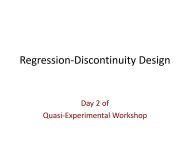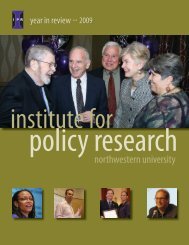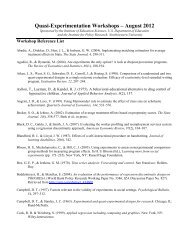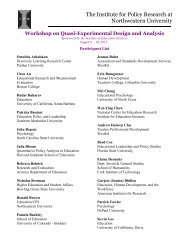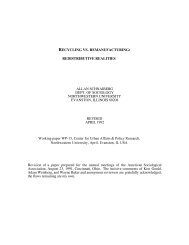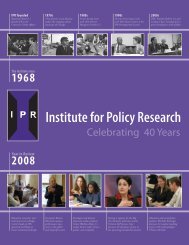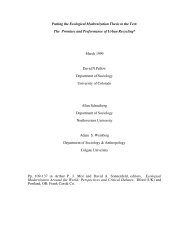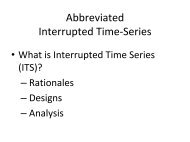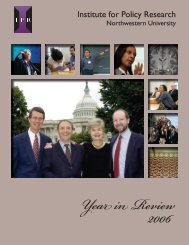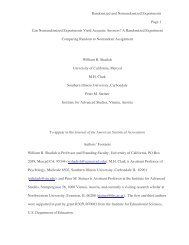Whatever Happened to the Emerging Democratic Majority?
Whatever Happened to the Emerging Democratic Majority?
Whatever Happened to the Emerging Democratic Majority?
You also want an ePaper? Increase the reach of your titles
YUMPU automatically turns print PDFs into web optimized ePapers that Google loves.
21<br />
A Forum for Ideas<br />
(continued from page 10)<br />
defeatism” in U.S. foreign policy led<br />
<strong>to</strong> <strong>the</strong> Republican rise starting in<br />
1968. By <strong>the</strong> early 1990s, however, <strong>the</strong><br />
recession, rising <strong>to</strong>lerance, and <strong>the</strong><br />
U.S. position as <strong>the</strong> world’s remaining<br />
superpower had chipped away at<br />
<strong>the</strong> Republican majority. By this<br />
time, three demographic groups had<br />
turned increasingly <strong>Democratic</strong>: single,<br />
John Judis<br />
college-educated women; minorities;<br />
and urban “knowledge” professionals<br />
(e.g., dentists, nurses, and computer programmers).<br />
Judis believes that <strong>the</strong> Democrats were on track <strong>to</strong> regain<br />
<strong>the</strong> majority even earlier than expected until Sept. 11, 2001.<br />
The ensuing “global war on terror” pushed defense and<br />
security, issues that typically favor Republicans, <strong>to</strong> <strong>the</strong> forefront<br />
of voters’ minds. Of <strong>the</strong> 42 percent who identifi ed national<br />
security as <strong>the</strong>ir major concern, 70 percent voted for Bush.<br />
“That’s <strong>the</strong> election right <strong>the</strong>re,” he said.<br />
Given <strong>the</strong> closeness of <strong>the</strong> 2000 and 2004 elections,<br />
plummeting support for <strong>the</strong> War in Iraq, and a meek economy,<br />
he thinks <strong>the</strong> Democrats stand a good chance of taking back<br />
<strong>the</strong> majority within three <strong>to</strong> four election cycles. Judis is <strong>the</strong><br />
author of five books including The <strong>Emerging</strong> <strong>Democratic</strong> <strong>Majority</strong><br />
with Ruy Teixiera (Scribner, 2002).<br />
P. Reese<br />
Judis believes that <strong>the</strong> Democrats<br />
were on track <strong>to</strong> regain <strong>the</strong> majority<br />
even earlier than expected until Sept.<br />
11, 2001.<br />
IPR discussant Benjamin I. Page praised Judis’ analysis and<br />
agreed that <strong>the</strong>re are opportunities for Democrats. But he<br />
warned that a purely demographic analysis does not take in<strong>to</strong><br />
account that political parties are “moving targets,” with evolving<br />
strategies and elite party cadres who might not necessarily<br />
align <strong>the</strong>mselves with <strong>the</strong> public. “The Democrats have been<br />
doing a terrible job of telling <strong>the</strong> working class exactly how<br />
<strong>the</strong>y will help <strong>the</strong>m in terms of jobs, education, and health<br />
care—<strong>the</strong> solid bread-and-butter New Deal issues,” he said.<br />
Page is Gordon S. Fulcher Professor of Decision Making and<br />
an IPR faculty associate.<br />
IPR Faculty Fellow Monica Prasad, <strong>the</strong> second discussant,<br />
pointed out that social groups also do not stand still. For<br />
example, it is not clear that African Americans and Hispanics<br />
will continue <strong>to</strong> vote <strong>Democratic</strong>. In interviewing working-class<br />
voters, she found many who espoused New Deal ideals, but<br />
thought it was not credible that a multimillionaire like John<br />
Kerry with fi ve homes would champion programs for <strong>the</strong><br />
poor. “Nominate a candidate who embodies your values,” she<br />
advised Democrats. She is assistant professor of sociology.<br />
Shaping Our Children’s Destinies<br />
(continued from page 8)<br />
of time <strong>to</strong> chop vegetables and go play in <strong>the</strong> park,” Butcher<br />
observed.<br />
In schools, Butcher found that by 2000, 85 percent of high<br />
schools made junk food available <strong>to</strong> children, and 50 percent<br />
allowed snack or soda ads. The sales of junk food and <strong>the</strong><br />
advertisements typically generate money for <strong>the</strong> schools that<br />
“principals can use <strong>to</strong> fund programs <strong>the</strong>y care about,” Butcher<br />
said. Financially strapped schools were <strong>the</strong> most likely <strong>to</strong> give<br />
students access <strong>to</strong> junk food. The increase in access <strong>to</strong> junk<br />
food in schools may account for 20 percent of <strong>the</strong> increase in<br />
<strong>the</strong> average adolescent Body Mass Index over <strong>the</strong> 1990s, she<br />
noted.<br />
To view <strong>the</strong> full presentations, please go <strong>to</strong><br />
www.northwestern.edu/ipr/events/briefing1104.html<br />
Inside <strong>the</strong> Black Box of Schools<br />
(continued from page 9)<br />
Rueben cited that across <strong>the</strong> board, experience seems <strong>to</strong><br />
matter. The most effective teachers have passed <strong>the</strong> initial<br />
three-<strong>to</strong>-fi ve-year learning curve.<br />
O<strong>the</strong>r possible indica<strong>to</strong>rs of teacher quality include <strong>the</strong><br />
teacher’s alma mater, verbal test performance, and state<br />
certification—though it is difficult <strong>to</strong> untangle whe<strong>the</strong>r<br />
<strong>the</strong> teachers are effective because of certifi cation or <strong>the</strong>ir<br />
experience, Rueben said.<br />
As <strong>to</strong> whe<strong>the</strong>r <strong>the</strong> best teachers are distributed equitably,<br />
Rueben said <strong>the</strong>y are not—mainly because teacher transfers<br />
are based on seniority. Thus more experienced teachers tend<br />
<strong>to</strong> be in—and can transfer <strong>to</strong>—schools in more affl uent areas,<br />
leaving less experienced teachers in high-poverty, high-minority<br />
areas where skilled instruc<strong>to</strong>rs are needed <strong>the</strong> most.<br />
To view <strong>the</strong> presentations, please go <strong>to</strong><br />
www.northwestern.edu/ipr/events/briefingFeb05.<br />
html<br />
Census Grants Program<br />
(continued from page 14)<br />
voluntary or involuntary had adverse effects. The adverse<br />
associations between fa<strong>the</strong>rs’ job losses and grade repetition<br />
are especially true for lower-income and younger children,<br />
whereas <strong>the</strong> associations between fa<strong>the</strong>rs’ job losses and<br />
suspension/expulsion are apparent for higher-income children<br />
in particular.<br />
For complete copies of <strong>the</strong> papers, please go <strong>to</strong><br />
www.jcpr.org/conferences/oldconferences/index.<br />
html



